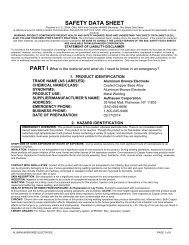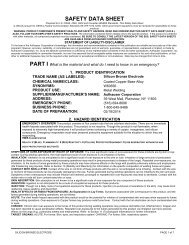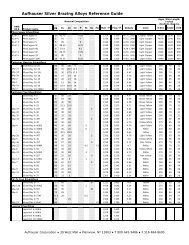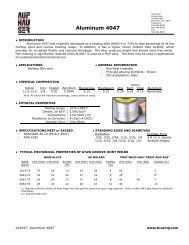MATERIAL SAFETY DATA SHEET - Aufhauser Corporation
MATERIAL SAFETY DATA SHEET - Aufhauser Corporation
MATERIAL SAFETY DATA SHEET - Aufhauser Corporation
Create successful ePaper yourself
Turn your PDF publications into a flip-book with our unique Google optimized e-Paper software.
PART III How can I prevent hazardous situations from occurring?<br />
7. HANDLING and STORAGE<br />
WORK PRACTICES AND HYGIENE PRACTICES: As with all chemicals, avoid getting this product ON YOU or IN YOU. Wash thoroughly after<br />
handling this product. Do not eat or drink while handling this product. Use ventilation and other engineering controls to minimize potential exposure to<br />
this product.<br />
STORAGE AND HANDLING PRACTICES: All employees who handle this product should be trained to handle it safely. Use in a well-ventilated<br />
location. Avoid breathing fumes of this product during welding operations. Open containers on a stable surface. Packages of this product must be<br />
properly labeled.<br />
When this product is used during welding operations, follow the requirements of the Federal Occupational Safety and Health Welding and Cutting<br />
Standard (29 CFR 1910 Subpart Q) and the safety standards of the American National Standards Institute for welding and cutting (ANSI Z49.1). Store<br />
packages in a cool, dry location. Store away from incompatible materials (see Section 10, Stability and Reactivity).<br />
PROTECTIVE PRACTICES DURING MAINTENANCE OF CONTAMINATED EQUIPMENT: Not applicable.<br />
8. EXPOSURE CONTROLS - PERSONAL PROTECTION<br />
VENTILATION AND ENGINEERING CONTROLS: Use with adequate ventilation to ensure exposure levels are maintained below the limits provided in<br />
Section 2 (Composition and Information on Ingredients). Prudent practice is to ensure eyewash/safety shower stations are available near areas where<br />
these products are used.<br />
RESPIRATORY PROTECTION: Maintain airborne contaminant concentrations below guidelines listed in Section 2 Composition and Information on<br />
Ingredients). If respiratory protection is needed (i.e., a Weld Fume Respirator, or Air-Line respirator for welding in confined spaces), use only protection<br />
authorized in 29 CFR 1910.134 or applicable State regulations. respiratory Protection is recommended to be worn during welding operations. Use<br />
supplied air respiration protection if oxygen levels are below 19.5% or are unknown.<br />
EYE PROTECTION: Safety glasses. When these products are used in conjunction with welding, wear safety glasses, goggles, or face-shield with filter<br />
lens of appropriate shade number (per ANSI Z49.1-1988, “Safety in Welding and Cutting”).<br />
HAND PROTECTION: Wear gloves for routine industrial use. When these products are used in conjunction with welding, wear gloves that protect from<br />
sparks and flame (per ANSI Z49.1-1988, “Safety in Welding and Cutting”).<br />
BODY PROTECTION: Wear body protection appropriate for task.<br />
9. PHYSICAL and CHEMICAL PROPERTIES<br />
The following information is for elemental iron:<br />
RELATIVE VAPOR DENSITY (air = 1): N/A<br />
EVAPORATION RATE (nBuAc = 1): N/A<br />
SPECIFIC GRAVITY @ 20C (water = 1): 7.86<br />
FREEZING/MELTING POINT: 1535C (2795F)<br />
SOLUBILITY IN WATER: Insoluble<br />
pH: Not Applicable<br />
VAPOR PRESSURE, mm Hg @ 1810C: N/A<br />
BOILING POINT @ 24 mm Hg: 3000C (5432F)<br />
ODOR THRESHOLD: Not Applicable<br />
COEFFICIENT OF OIL/WATER DISTRIBUTION (PARTITION COEFFICIENT): Not Applicable<br />
APPEARANCE AND COLOR: These products consist of solid wire or rods, which are odorless and may be copper coated.<br />
HOW TO DETECT THIS SUBSTANCE (warning properties): The appearance is a distinctive characteristic of this product.<br />
10. STABILITY and REACTIVITY<br />
STABILITY: Stable.<br />
DECOMPOSITION PRODUCTS: Iron compounds and metal oxides.<br />
NOTE: The composition and quality of welding fumes and gases are dependent upon the metal being welded, the process, the procedure, and the<br />
electrodes used. Other conditions that could also influence the composition and quantity of fumes and gases to which workers may be exposed include<br />
the following: any coatings on metal being welded (e.g., paint, plating, or galvanizing), the number of welders and the volume of the work area, the<br />
quality of ventilation, the position of the welder’s head with respect to the fume plume, and the presence of other contaminates in the atmosphere. When<br />
the electrode is consumed, the fume and gas decomposition products generated are different in percent and form from the ingredients listed in Section 2<br />
(Composition and Information on Ingredients). Fume and gas decomposition products, and not the ingredients in the electrode, are important.<br />
Concentration of the given fume or gas component may decrease or increase by many times the original concentration. New compounds in the<br />
electrode may form. Decomposition products of normal operations include not only those originating from volatilization, reaction, or oxidation of the<br />
product’s components but also those from base metals and any coating (as noted previously). The best method to determine the actual composition of<br />
generated fumes and gases is to take an air sample from inside the welder’s helmet if worn or in breathing zone. For additional information, refer to the<br />
American Welding Society Publication, “Fumes and Gases in the Welding Environment”.<br />
<strong>MATERIAL</strong>S WITH WHICH SUBSTANCE IS INCOMPATIBLE: Strong acids, strong oxidizers, mineral acids, and halogens.<br />
HAZARDOUS POLYMERIZATION: Will not occur.<br />
CONDITIONS TO AVOID: Uncontrolled exposure to extreme temperatures, Incompatible materials.<br />
PART IV Is there any other useful information about this material?<br />
11. TOXICOLOGICAL INFORMATION<br />
TOXICITY <strong>DATA</strong>: Presented below are human toxicological data available for the components of these products present in concentration greater than<br />
1%. Other data for animals are available for the components of these products, but are not presented in this <strong>SAFETY</strong> <strong>DATA</strong> <strong>SHEET</strong>.<br />
ER70S2, ER70S3, E70S6 PAGE 4 of 7






